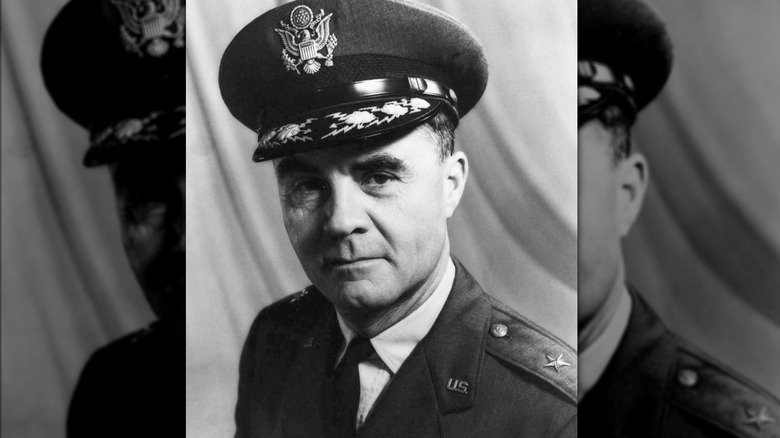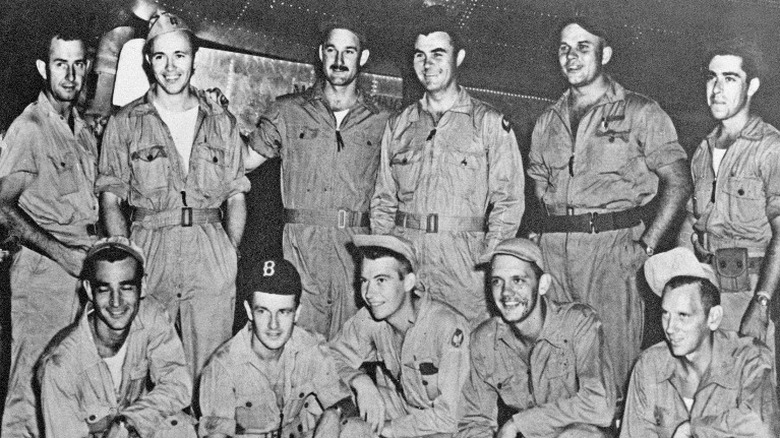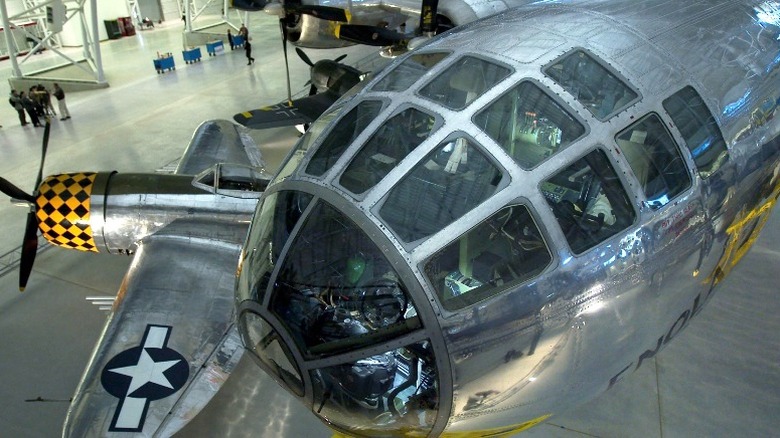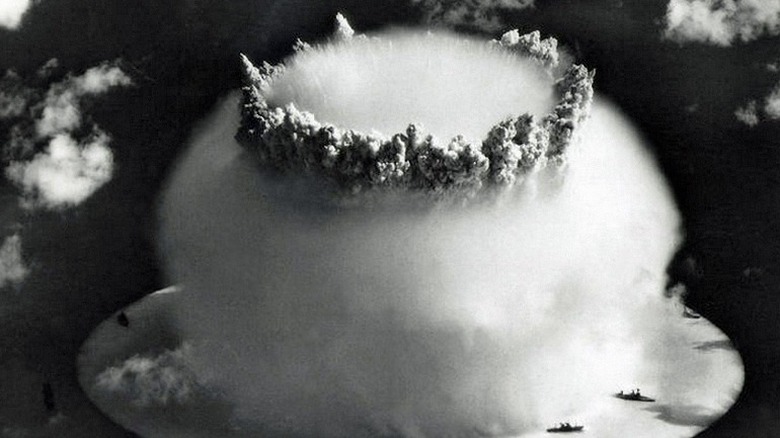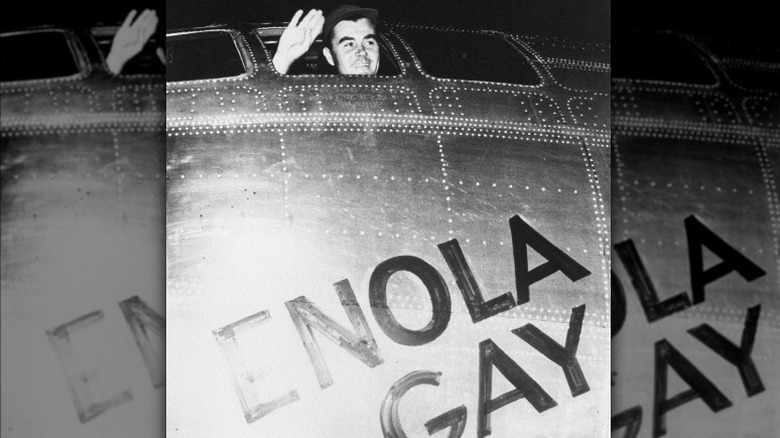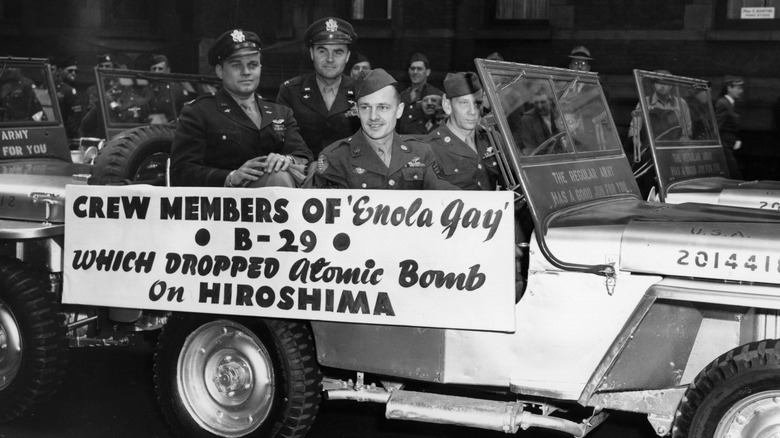Who Was Paul Tibbets, The Man Who Dropped The Atomic Bomb On Hiroshima?
Every war produces heroes and villains. But perhaps the war that will be known for having the most notable figures from all sides is the great global conflict known as World War II. The war ravaged the entire continent of Europe, while also producing devastation and massive casualties in Asia and North Africa. It seemed like no place on Earth was safe from battle, as Allied and Axis forces vied for control of nations and colonies.
The names of both Allied and Axis players will be forever etched in history. Patton, Eisenhower, Churchill, MacArthur, Roosevelt, and Truman will be among those that will be discussed in the history books far into the future. Hirohito, Hitler, Mussolini, and more will continue to be vilified for their crimes against humanity, hopefully serving as a lesson warning against the powers of dictatorships.
With the war in Europe decidedly over in the spring of 1945, the war continued in the Pacific. Japan had been quickly losing its control over the vast territory it had claimed since it had been defeated at the Battle of Midway Island in June 1942, putting them on the defensive for the remainder of the war (via History). Even as much of their map had shrunk, Japan showed no signs of surrendering. The atomic bomb changed that quickly, as the U.S. employed a still controversial move that would lead to the remaining Axis power surrendering on September 2, 1945 (also via History). We know President Truman ordered the two bombs dropped over Japanese cities Hiroshima and Nagasaki. But who flew the mission to drop the first nuclear bomb?
Paul Tibbets was selected after successful raids over Europe and Japan
Paul Tibbets (standing, above, fourth from left) began his military career by enlisting in the U.S. Army Air Corps, the precursor to the Air Force. The New Yorker tells us that Tibbets entered the service in 1938, just as trouble was beginning to brew in Europe. He learned to fly, serving the entirety of his three-year enlistment. By the end of that period, he had been promoted to the rank of captain and the dam was getting ready to break across both the Atlantic and the Pacific.
In 1942, Tibbets found himself piloting planes on bombing raids on two continents — over parts of Africa, as well as over occupied France, where he flew 25 missions (per Atomic Heritage).
Tibbets had quickly earned a reputation as being one of the best pilots in the United States military. This resulted in him being called back stateside and being assigned as a test pilot for the new B-29s. He told The New Yorker that he was working one day when a general summoned him. In the office of his commander, he was told that he was now "the member of the Air Corps who may henceforth consider the atomic bomb your baby." In 1944, Tibbets received a briefing on the Manhattan Project, his introduction to nuclear weapons. He was also assigned nearly 2,000 men under his command as he led the 509th Composite Group. This, according to Atomic Heritage, was the arm of the Manhattan Project that would be responsible for delivering the bombs' payload over Japan.
The Enola Gay was named after Tibbets' mother
For understandable reasons, Tibbets had to keep his knowledge of the Manhattan Project under wraps. The New Yorker reports that aside from the assigned bombardier and navigator, only a handful of men from the entire squadron knew of the potential mission. And when the time came to drop the nuke from his plane on that August morning, Tibbets said that those aboard treated it like any other bombing mission that they'd accomplished. He remarked, "All we wanted was for the thing to go off right, after all our work."
The bomb, nicknamed "Little Boy," was dropped from Tibbets' plane, the Enola Gay, named after Tibbets' mother. Little Boy exploded on Hiroshima on August 6, 1945 (per History). Days later, on August 9, a second aircraft named Bockscar dropped a more powerful bomb on the city of Nagasaki (via Atomic Heritage). Known by the nickname "Fat Man," this bomb caused mass destruction in the port city. Bockscar was piloted not by Tibbets, but by Charles Sweeney (per Newsweek).
The death tolls reported for both cities range widely, due to the level of destruction the bombs were responsible for. The death toll was substantial, however, and prompted Japanese leadership to surrender within weeks of the initial atomic strike.
Tibbets retired as a Brigadier General
Tibbets did not end his career in the military after the war was over. Atomic Heritage reports that he was a technical advisor for the military in 1946, serving during the nuclear tests performed during Operation Crossroads. This military operation involved the detonation of two nuclear bombs at the Bikini Atoll (above), the first detonation of nuclear devices since the bombings of Hiroshima and Nagasaki (via Naval History and Command).
Tibbets continued to rise in the ranks of the U.S. military, achieving the rank of Brigadier General (via The New York Times). One of his last assignments was participating in the United States Supply Line mission to India, where he was not well received by political factions in the country. He was dubbed "the world's greatest killer" by the Indian Communist Party, causing some embarrassment for the U.S. State Department. After nearly 30 years in uniform, Tibbets retired on August 31, 1966 (via Spartacus Educational). He then took a job in aviation in Ohio, eventually becoming the chairman of Executive Jet Aviation.
The bombings of Hiroshima and Nagasaki remain hotly debated topics decades later. Tibbets maintained that the bombings, while killing thousands of people, saved more lives than they cost. In his autobiography, "The Tibbets Story," he claimed that he was so sure of the decision that he "never lost a night's sleep" over his participation (via The Guardian).
Tibbets felt no regret about his actions during the war
Tibbets was the center of controversy some years after his retirement. In 1976, he participated in a reenactment of the Hiroshima bombing at an air show in Harlingen, Texas. NPR reports that Tibbets was flying a B-29 Superfortress as part of the event. As the aircraft passed over the runway, a device detonated below him, creating a mushroom cloud. Though he later insisted that his actions were "not intended to insult anybody," he was met with some heavy scrutiny. Japan was furious about the display, as were many others. The U.S. government issued a formal apology.
Atomic Heritage relates that the Smithsonian Institution had planned a 50th-anniversary exhibit of the Enola Gay. This was met with heavy scrutiny as well, prompting the final exhibit to be scaled back from its original design. Tibbets was vocal on the outrage against the display, defending both it and the U.S. decision to use nuclear weapons during the war.
In a 2002 interview with Studs Terkel, Tibbets revealed more of his true feelings about the use of nuclear weapons to end the war. When asked if he ever had any second thoughts about it, he replied, "No. ... Number one, I got into the air corps to defend the United States to the best of my ability. That's what I believe in and that's what I work for." He continued, impressing that though he knew that "we're going to kill a lot of people, but by God, we're going to save a lot of lives. We won't have to invade" Japan. (The transcript is posted at AV Web).
Tibbets had his ashes spread over the English Channel
Tibbets died at the age of 92 on November 1, 2007 (via NPR). His final wishes were to be cremated and have his ashes strewn over the English Channel, a body of water that he flew over dozens of times throughout his military career.
Understandably, Tibbets did not want a grave or a memorial marker. He had concerns that any memorial dedicated to his memory would be subject to protests and vandalism, as there are many people worldwide who feel passionately about the devastation that he participated in.
To this day, Tibbets and his Hiroshima mission remain controversial subjects. Whether or not the decision to drop nuclear bombs on civilian populations was an immoral act that resulted in needless death and destruction, or was a strategic plan to end a war and save countless other lives, is subject to debate. What we do know is that no such nuclear device has been used since, and hopefully never will be.
